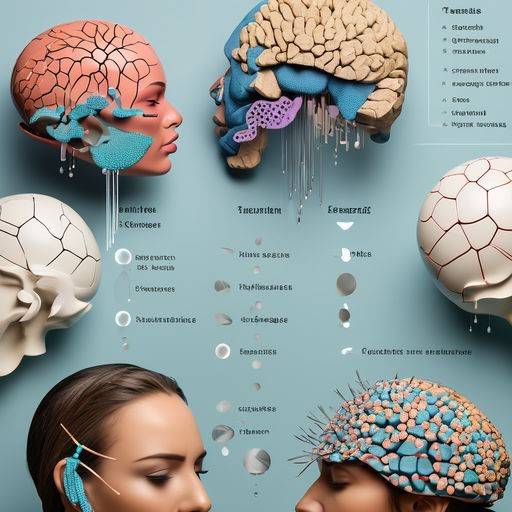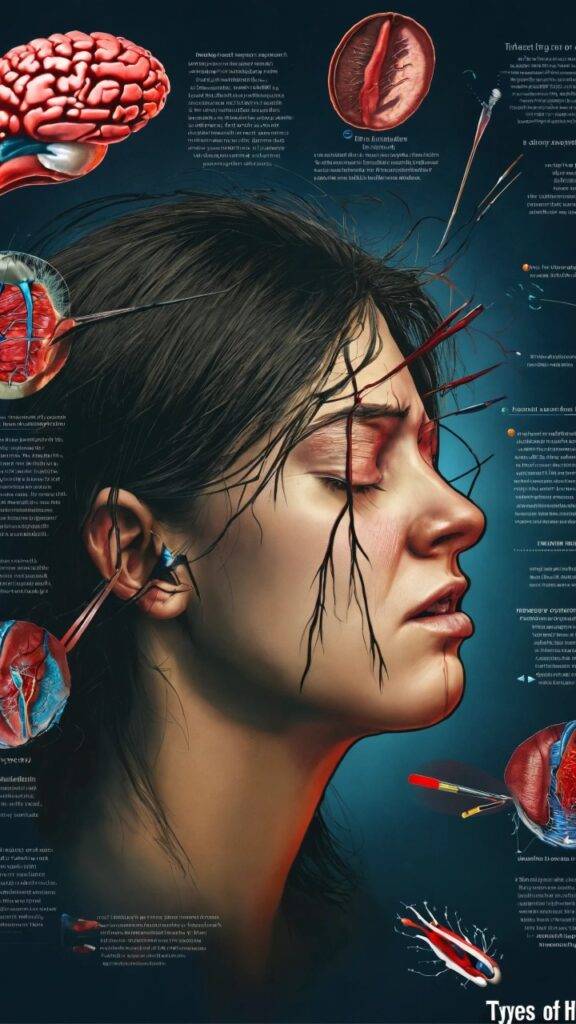Types of Headaches and Location: Understanding Your Head Pain
Understand different types of headaches and locations to identify and manage head pain effectively.
Key Takeaways: Types of Headaches and Location

- Types of headaches and location can provide valuable clues about the underlying cause of your head pain.
- Common headache types include migraines, tension headaches, cluster headaches, and sinus headaches.
- Head pain locations like one-sided, front, back, or whole head can indicate different types of headaches and locations.
- Identifying headache type and specific location is key for getting proper treatment and relief.
- Keeping a headache diary can help track patterns in types of headaches and locations.
The Clues Behind Your Cranium Discomfort
Headache pain can manifest in many ways – a dull ache, sharp stabbing sensation, pounding throbs, or constant pressure. Beyond just the intensity, the specific types of headaches and location can provide valuable clues about what’s causing those unpleasant head pains.
By better understanding common headache varieties and what the location of your pain might signal, you can gain insight into the root issue. This can then help guide you and your doctor toward the most appropriate treatment plan for relief.
In this comprehensive guide, we’ll explore primary types of headaches and location patterns, as well as what those cranial clues could potentially indicate. Accurate identification is often the first step to conquering frustrating, recurring head pain.
Common Types of Headaches Categorized
While there are several dozen clinically recognized headache classifications, most cases fall into a few main categories and subtypes such as:
Migraines
One of the most common and severe types of headaches. Migraines typically involve:
- Severe, pounding, one-sided head pain.
- May have aura symptoms like light sensitivity.
- Often accompanied by nausea and vomiting.
- Can last anywhere from hours to days.
There are also different migraine subtypes like chronic migraines and menstrual migraines.
Tension-Type Headaches
One of the most frequently occurring types of headaches. Tension headache traits:
- Dull, non-pulsating pain that feels “tight.”
- Usually affects both sides of the head.
- Not exacerbated by routine activity
- No nausea or vomiting
- Can last for minutes or persist for weeks.
Cluster Headaches
Though less common, these are one of the most severe types of headaches:
- Extreme pain is often focused around one eye.
- Pain comes in cyclical patterns or “clusters.”
- Episodes can last weeks or months, separating over time.
- Often accompanied by nasal congestion, eye redness/tearing
Sinus Headaches
Caused by sinus inflammation, congestion, or infection. Sinus headache symptoms:
- Pressure/pain across forehead, cheeks, or brow area.
- Often worsened by bending or straining
- Accompanied by nasal discharge, fever, etc.
There are many other less common types of headaches like hormone headaches, exercise headaches, thunderclap headaches, and more.
Now, let’s look at how the location of head pain corresponds with different headache varieties.
Headache Locations: What They Could Indicate
The specific location where you experience cranial pain and pressure can reveal insights into the underlying types of headaches and location you might be dealing with:
| Location of Pain | Potential Headache Type(s) |
| One-sided/Unilateral | Migraines, cluster headaches, sinus headaches |
| Whole head | Tension headaches, migraines, post-traumatic headaches |
| Front of Head | Tension headaches, sinus headaches, migraines |
| Back/Base of Head | Tension headaches, arthritis headaches, neck issues |
| Behind One Eye | Cluster headaches, migraines |
| Temples | Tension headaches, temporomandibular issues |
Typically, one-sided head pain is indicative of migraines, cluster headaches, or sinus problems affecting that side. When the pain is generalized across the entire skull, tension headaches, and migraines are more likely culprits.
However, headache location alone doesn’t provide a definitive diagnosis – it’s just one clue that needs to be considered holistically alongside other symptoms and factors.
So, while whole-head pain points more toward tension-type headaches, migraines frequently start one-sided before becoming more generalized over time as well. And of course, head pain location can vary even within the same headache type from person to person.
Getting to the Root of Recurring Headache Pain
Identifying the specific types of headaches and locations you frequently experience is just the first step toward finding effective treatment and management. Once you can categorize the pattern of your headache symptoms, the next crucial steps are:
Keep a Headache Diary for Tracking
Recording details like:
- Pain location
- Accompanying symptoms
- Potential triggers
- Duration and timing
- What provides relief?
This creates a valuable log to share with your doctor and can reveal patterns over time.
Identify Potential Triggers
Common headache triggers include:
- Hormonal fluctuations
- Lack of sleep
- Specific foods/drinks
- Environmental factors
- Stress and anxiety.
- Physical strain/exertion
Once you know the type of headache you get, you can be more aware of possible triggers.
Rule Out Any Underlying Conditions
More serious types of headaches can sometimes be caused by other medical issues like:
- Traumatic brain injuries
- Brain tumors/aneurysms
- Temporomandibular disorders (TMJ)
- Stroke
It’s critical to rule these out, especially in cases of sudden, severe, or changing headache patterns.
Try Prevention Tactics First
Preventive measures like:
- Staying hydrated
- Getting adequate sleep
- Managing stress levels
- Improving posture/ergonomics
- Limiting dietary headache triggers
- Regular exercise/stretching.
Can help reduce symptom frequency before relying too heavily on medication.
Explore All Treatment Options
If prevention fails, numerous treatment paths exist depending on headache types:
- Over-the-counter pain relievers
- Prescription preventive or acute meds
- Procedures like nerve blocks or Botox
- Physical therapy for musculoskeletal issues
- Stress-management therapy.
The key is finding the most effective, sustainable solution based on your specific diagnosis.
Finding lasting relief often requires a comprehensive, multi-pronged approach guided by in-depth knowledge of types of headaches and location patterns. My popular headache/migraine guide explores this further.
Headache FAQs: Getting to the Head of Your Pain
What are the main types of headaches?
The primary categories of headaches include migraines, tension-type headaches, cluster headaches, and sinus headaches. However, there are many specific subtypes within those larger groups that vary based on factors like cause, symptoms, and location of pain.
What does a migraine headache feel like?
Migraines typically cause severe, pounding, one-sided head pain often accompanied by nausea, vomiting, light/sound sensitivity, and sometimes an aura of visual disturbances or other neurological symptoms. The intensity and location can vary but migraines are usually quite debilitating.
Where do tension headaches hurt?
Tension headaches tend to cause a dull, non-pulsating, band-like pain across the entire head or specific areas like the forehead, temples, or base of the skull. The pain is often described as tight, pressing, or a muscle strain sensation.
What causes sinus headaches and where is the pain?
Sinus headaches stem from inflammation or congestion in the sinus cavities, usually triggered by allergies, infections, or similar issues. The pain is often focused across the forehead, cheeks, around the nose/eyes, or top of the head.
How can I tell if my headaches are serious?
While most headaches aren’t life-threatening, some red flags signal the need for prompt medical attention. See a doctor immediately if you experience sudden, severe “thunderclap” headaches, headaches with neurological symptoms like paralysis or difficulty speaking, headaches after head trauma, or a dramatic new headache pattern.
Are headaches that move locations a concern?
Not necessarily – it’s common for headache pain to shift locations as the headache progresses. Migraines tend to start on one side but may spread across the entire head over time. However, any sudden changes in typical headache location or patterns should be evaluated by a doctor to rule out anything serious.
Conclusion
Understanding the different types of headaches and location patterns is crucial for getting to the root cause of your head pain. Whether it’s a severe migraine, nagging tension headache, or a cluster of sinus pressure, identifying the headache variety and region of discomfort provides important clues.
By keeping track of your symptoms, locations, and potential triggers in a headache diary, you can work with your doctor to pinpoint the type of headache you’re experiencing. This opens the door to exploring preventive methods and finding the most effective treatment solution for long-lasting relief.
Don’t let ongoing headache misery derail your life. Get familiar with common types of headaches and location signals so you can take control and overcome that cranium discomfort once and for all.



